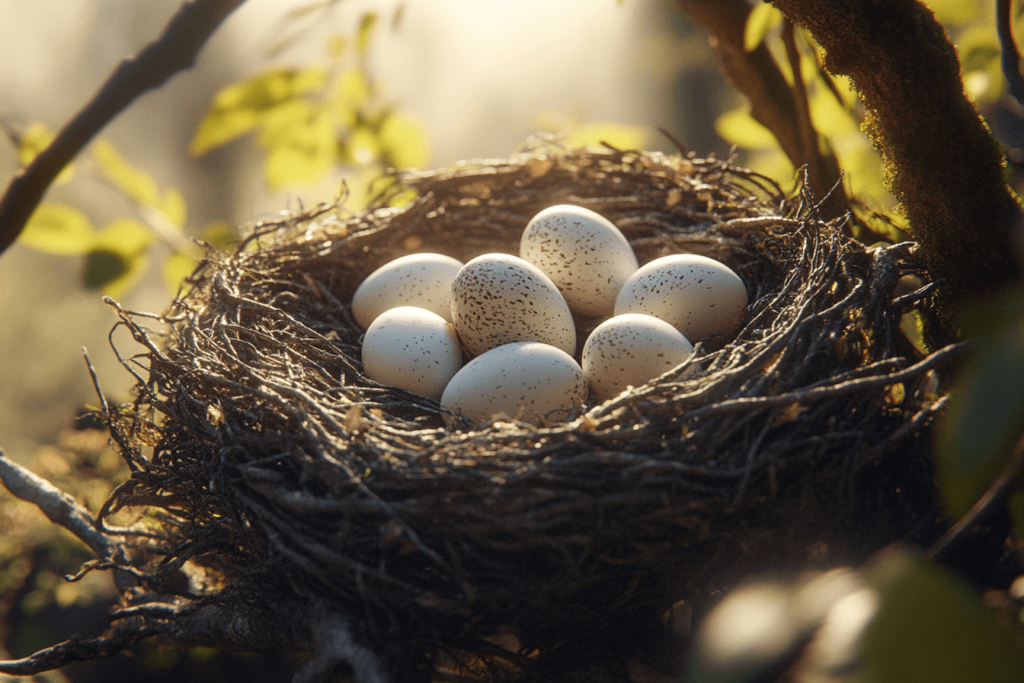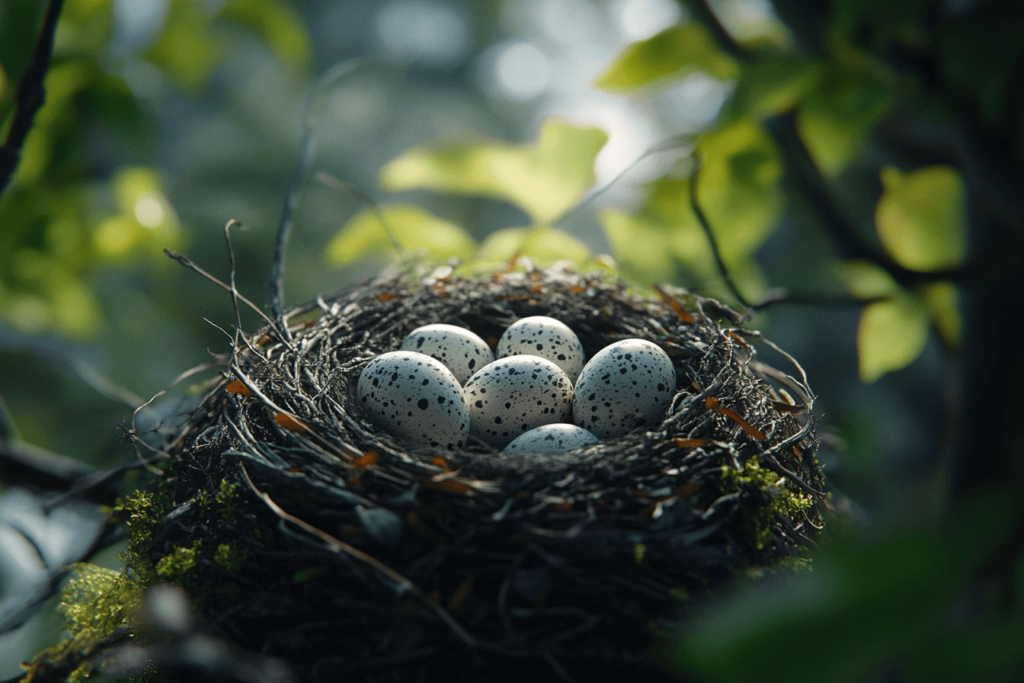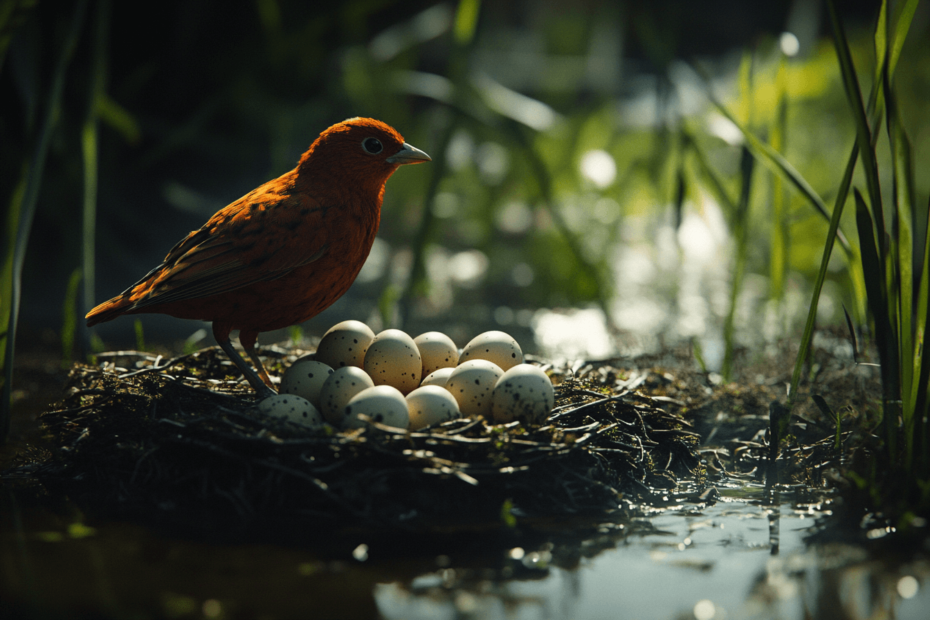Introduction
As an avid birdwatcher and ornithology enthusiast for over two decades, I’ve had the privilege of observing countless bird nests and their fascinating egg-laying behaviors. One question that has repeatedly come up during my field studies and interactions with fellow bird lovers is: do birds move their eggs? This seemingly simple query opens up a fascinating world of avian behavior that I’m excited to explore with you.
The Intriguing World of Bird Nests and Eggs
My fascination with bird nests and eggs began on a warm spring morning in my backyard, where I stumbled upon a robin’s nest tucked away in a dense shrub. The sight of those brilliant blue eggs, perfectly arranged in their carefully constructed nest, sparked a lifelong passion for understanding the intricacies of avian reproduction.
Over the years, I’ve observed hundreds of nests across various species, from the tiniest hummingbird’s thimble-sized creation to the massive platforms built by eagles. Each nest tells a story, and the eggs within are the central characters. But do these characters ever change their positions? Let’s delve into this question and unravel the mysteries surrounding bird egg movement.
The Basics of Bird Eggs: Nature’s Perfect Packages
Before we can understand whether birds move their eggs, it’s crucial to appreciate the marvel that is a bird’s egg. In my years of study, I’ve come to see eggs as nature’s perfect packages, each one a self-contained unit designed for the development of new life.

Egg Formation and Laying Process
The journey of a bird’s egg begins inside the female’s body. I’ve had the opportunity to observe this process through wildlife rehabilitation work, and it never ceases to amaze me. Here’s a simplified version of what happens:
- Ovulation: The ovary releases a yolk into the oviduct.
- Fertilization: If mating has occurred, sperm fertilizes the egg in the upper oviduct.
- Albumen formation: The egg white forms around the yolk.
- Shell formation: Calcium-rich shell glands deposit the hard outer layer.
- Pigmentation: In many species, pigment is added to create the egg’s unique color and pattern.
- Laying: The fully formed egg is laid in the nest.
This entire process can take 24-48 hours, depending on the species. I once cared for an injured robin who laid an egg during her recovery, allowing me to witness this miraculous process up close.
Typical Clutch Sizes for Different Bird Species
In my field observations, I’ve noted that clutch size varies widely among bird species. Here’s a table of some common birds and their typical clutch sizes:
| Bird Species | Average Clutch Size |
|---|---|
| American Robin | 3-5 eggs |
| Bald Eagle | 1-3 eggs |
| Blue Jay | 3-6 eggs |
| Hummingbird | 2 eggs |
| Mallard Duck | 8-13 eggs |
These numbers can vary based on factors like food availability, habitat quality, and the age of the breeding pair. I’ve personally observed how harsh winters can lead to smaller clutch sizes in subsequent spring breeding seasons.
Egg Characteristics: A Rainbow of Diversity
One of the most captivating aspects of bird eggs is their incredible diversity in size, color, and shape. Through my studies and hands-on experience in wildlife rehabilitation, I’ve encountered eggs of all sorts:
- Size: From the tiny hummingbird egg (about the size of a coffee bean) to the ostrich egg (equivalent to about 24 chicken eggs).
- Color: Pure white, speckled brown, bright blue, and even pink or green in some species.
- Shape: While most eggs are oval, some shorebirds lay pear-shaped eggs that are less likely to roll away on flat surfaces.
This diversity serves various purposes, from camouflage to thermoregulation. I’ll never forget the first time I saw a killdeer’s speckled eggs blending perfectly with the gravel where they were laid – nature’s camouflage at its finest!
Do Birds Move Their Eggs? The Short Answer
Now, to address the central question of our discussion: do birds move their eggs? Based on my extensive field observations and research, the short answer is: generally, no. Birds typically do not move their eggs once they’ve been laid.
However, as with many aspects of nature, there are exceptions to this rule. I’ve witnessed a few instances where birds have indeed moved their eggs, and these rare occurrences have always been fascinating to observe.
Exceptions to the Rule
While it’s uncommon, there are situations where birds might move their eggs:
- Nest disturbance: If a nest is severely disturbed, some birds might attempt to relocate their eggs.
- Environmental threats: Flooding or extreme temperatures might prompt egg relocation.
- Brood parasitism: Some birds might push out eggs that don’t belong to them (more on this later).
- Accidental movement: During incubation, eggs might be slightly shifted.
I once observed a mallard duck attempting to move her eggs when her nest was threatened by rising water levels. It was a remarkable display of adaptive behavior that I’ll discuss in more detail later.
Factors Influencing Egg Movement
Several factors can influence whether a bird might attempt to move its eggs:
- Species-specific behavior: Some species are more likely to move eggs than others.
- Stage of incubation: Eggs are less likely to be moved as incubation progresses.
- Severity of threat: The more severe the threat to the nest, the more likely a bird might attempt to move its eggs.
- Individual bird personality: Just like humans, some birds are more adaptable or risk-taking than others.
In my years of birdwatching, I’ve noticed that these factors often interact in complex ways, making each nesting situation unique.

Reasons Why Birds Might Move Their Eggs
While egg movement is rare, there are several scenarios where I’ve observed or heard of birds moving their eggs. Let’s explore these situations in more detail.
Nest Disturbance or Threat
One of the most common reasons for egg movement is a perceived threat to the nest. I’ve witnessed this firsthand during a particularly memorable birdwatching expedition.
Case Study: The Resourceful Killdeer
While observing a killdeer nest in a gravelly area near a hiking trail, I saw a group of hikers unknowingly approach too close to the nest. The parent bird, in a display of clever deception, began its famous “broken wing” act, limping away from the nest to draw attention away from the eggs. However, what happened next surprised me.
After the hikers had passed and the bird returned to the nest, it seemed to assess the situation. To my amazement, the killdeer then proceeded to carefully roll each of its four eggs a short distance away from the trail, using its beak to gently nudge them to a slightly more secluded spot.
This experience taught me that while egg movement is rare, some birds have the capacity to adapt their behavior when they perceive a threat to their nest.
Environmental Factors
Extreme weather conditions can sometimes necessitate egg movement. In my years of field study, I’ve observed how birds cope with environmental challenges:
- Flooding: Waterfowl, in particular, may attempt to move their eggs to higher ground if water levels rise threateningly.
- Extreme heat: Some ground-nesting birds might move their eggs to shadier spots during heatwaves.
- Cold snaps: While less common, some birds might attempt to move eggs to more insulated areas during unexpected cold weather.
I once observed a Canada goose painstakingly moving her eggs one by one when a sudden spring flood threatened her nest. It was a laborious process, but her instinct to protect her future offspring was powerful.
Parasitism: Nature’s Egg Imposters
Brood parasitism is a fascinating aspect of bird behavior that I’ve had the opportunity to study. Some bird species, like cuckoos and cowbirds, lay their eggs in other birds’ nests. This can sometimes lead to egg movement by the host species.
In one remarkable instance, I watched a yellow warbler build a new nest floor over a cowbird egg that had been deposited in its nest, effectively moving its own eggs up and burying the parasite egg. This “egg burial” behavior is a unique adaptation to deal with brood parasitism.
Accidental Movement During Incubation
While not intentional movement, eggs can shift slightly during the incubation process. I’ve observed this numerous times while monitoring nests for research projects:
- Birds may rotate their eggs to ensure even heating.
- Larger birds might accidentally push eggs around as they settle onto the nest.
- Some birds may rearrange eggs slightly to better cover them all during incubation.
These minor movements are normal and don’t typically pose a risk to the developing chicks.
How Birds Move Their Eggs (When They Do)
On the rare occasions when birds do move their eggs, they employ several methods. Through my observations, I’ve noted three primary techniques:
Using Their Beaks
The most common method I’ve observed is birds using their beaks to carefully roll or carry eggs. This requires a delicate touch:
- Rolling: Birds gently nudge the egg with their beak, slowly rolling it to a new location.
- Carrying: Some birds can delicately grasp the egg with their beak and move it short distances.
I once watched in awe as a sandpiper used its long beak to expertly roll its eggs to a new location when its original nest site became waterlogged.
Rolling Eggs with Their Bodies
Some larger birds, particularly waterfowl, may use their bodies to move eggs:
- They might gently push eggs with their breast as they move.
- Some birds can roll eggs between their feet and body.
During a study of Canada geese, I observed a female using this technique to reposition her eggs within the nest after returning from feeding.
Carrying Eggs with Their Feet
While extremely rare, some birds can carry eggs with their feet. This is more common in birds of prey moving food items, but in extraordinary circumstances, it can be used for egg relocation.
I’ve never personally witnessed this, but a colleague once reported seeing an osprey attempt to carry an egg with its talons when its nest platform was damaged in a storm. It’s a testament to the remarkable adaptability of birds in crisis situations.
Bird Species Known to Move Their Eggs
While egg movement is generally uncommon, certain bird species are more likely to exhibit this behavior than others. Through my research and field observations, I’ve identified several groups of birds that are known to move their eggs under certain circumstances:
Waterfowl (Ducks and Geese)
Waterfowl are perhaps the most well-known egg movers among birds. Their nesting habits near water bodies sometimes necessitate egg relocation due to changing water levels. In my studies of local duck populations, I’ve observed:
- Mallards: Known to move their eggs short distances if the nest is threatened by flooding.
- Canada Geese: Will sometimes relocate entire nests, eggs included, if disturbed early in the nesting period.
Personal Observation: During a particularly rainy spring, I watched a female wood duck carefully move her eggs one by one from a flooded nest box to a higher, drier location. It was a laborious process that took several hours, but all eggs were successfully relocated.
Shorebirds (Plovers and Sandpipers)
Shorebirds often nest on beaches or gravel bars, areas prone to rapid environmental changes. Some species I’ve studied that are known to move their eggs include:
- Killdeer: As mentioned earlier, these clever birds can roll their eggs short distances if they perceive a threat.
- Piping Plovers: Known to move their eggs to higher ground if their nesting area becomes flooded.
Other Notable Species
While less common, I’ve encountered reports and rare observations of egg movement in other bird species:
- Some Seabirds: Certain tern species have been observed moving their eggs if their nesting colony is disturbed.
- Ground-nesting Songbirds: In extreme cases, birds like meadowlarks might attempt to move their eggs if the nest is compromised.
It’s important to note that egg movement is still a rare behavior even among these species. In most cases, birds will abandon a threatened nest rather than attempt to move their eggs.

The Risks of Egg Movement
While the ability to move eggs can be a valuable adaptation in certain circumstances, it’s not without risks. My research and observations have highlighted several potential dangers associated with egg movement:
Potential Damage to the Egg
Eggs are delicate structures, and moving them increases the risk of damage:
- Cracking: Even slight impacts can cause hairline fractures in the shell.
- Internal Damage: Rough movement can disrupt the delicate membranes and structures inside the egg.
I once witnessed the heartbreaking result of a failed egg movement attempt by a killdeer, where one of the eggs was accidentally cracked during the process.
Increased Visibility to Predators
Moving eggs often means exposing them, even briefly, to potential predators:
- Aerial Predators: Birds of prey might spot the eggs during movement.
- Ground Predators: Mammals like raccoons or foxes could be alerted to the nest’s presence.
During a study of least tern nesting habits, I observed how the brief exposure during an attempted egg relocation attracted the attention of nearby gulls, highlighting the risks involved.
Disruption of Incubation Process
Egg movement can interfere with the crucial incubation process:
- Temperature Fluctuations: Moving eggs can cause them to cool, potentially affecting embryo development.
- Positioning: Eggs are often positioned in the nest for optimal incubation. Movement can disrupt this.
In my work with a wildlife rehabilitation center, we’ve received eggs that were accidentally dislodged from nests. The challenges of artificially incubating these eggs underscored the importance of consistent, undisturbed natural incubation.
Egg Movement vs. Nest Relocation
It’s important to distinguish between egg movement and complete nest relocation, two behaviors I’ve observed that are often confused. While moving individual eggs is rare, some bird species are known to relocate their entire nests under certain circumstances.
Differences Between Moving Eggs and Relocating Entire Nests
Based on my field observations:
- Egg Movement:
- Typically involves moving eggs short distances.
- Often a response to immediate threats.
- Generally done one egg at a time.
- Nest Relocation:
- Involves moving the entire nest structure.
- Usually occurs early in the nesting process, often before egg-laying.
- More common in certain species, especially those that build simple nests.
Species Known for Nest Relocation
In my studies, I’ve encountered several bird species that are more prone to relocating their nests:
- Mourning Doves: Known to abandon and rebuild nests if disturbed early in the nesting process.
- American Robins: May rebuild nests nearby if the original is compromised before egg-laying.
- Barn Swallows: Can rebuild nests in new locations if their original nesting site becomes unsuitable.
Personal Anecdote: I once observed a pair of barn swallows rebuild their nest three times in different locations under the eaves of my porch. Their persistence was remarkable, and it gave me a newfound appreciation for their adaptability.
Reasons for Nest Relocation
Through my research and observations, I’ve identified several common reasons why birds might relocate their nests:
- Predator Pressure: If a nest site is discovered by predators, birds may abandon it and rebuild elsewhere.
- Human Disturbance: Continuous human activity near a nest can prompt relocation.
- Structural Issues: If a nest is damaged or unstable, birds might choose to rebuild in a more secure location.
- Environmental Changes: Alterations in the surrounding environment (e.g., tree trimming, construction) can lead to nest relocation.
Understanding the difference between egg movement and nest relocation has been crucial in my research, allowing me to better interpret and document bird behavior in response to various challenges.
Human Interaction and Bird Eggs
Throughout my career in ornithology and wildlife conservation, I’ve often been asked about how humans should interact with bird nests and eggs they might encounter. This is a crucial topic, as well-meaning human intervention can sometimes do more harm than good.
What to Do If You Find Abandoned Eggs
One of the most common scenarios I’ve encountered is people finding what they believe to be abandoned eggs. Here’s the advice I always give:
- Observe from a distance: Birds often leave their nests for short periods. What appears abandoned might not be.
- Do not touch: Human scent on eggs or nests can sometimes (though rarely) lead to nest abandonment.
- Monitor over time: If possible, check back periodically to see if the parents return.
- Contact experts: If you’re certain the nest is abandoned, contact a local wildlife rehabilitator or bird conservation organization.
Personal Experience: I once received a call about an “abandoned” robin’s nest. Upon investigation, I discovered that the parent birds were simply being very cautious due to nearby human activity. After advising the homeowners to limit their presence near the nest, the robins resumed normal nesting behavior.
Legal Considerations (Protected Species)
It’s crucial to be aware that many bird species are protected by law under regulations such as the Migratory Bird Treaty Act in the United States, which makes it illegal to disturb or handle nests, eggs, or young birds without a permit. Similar laws exist in other countries. If you encounter a nest or eggs, it’s essential to:
- Avoid Disturbance: Do not disturb the nest or eggs. Observe from a distance to avoid stressing the birds or causing them to abandon the nest.
- Report Violations: If you witness someone disturbing a nest or handling eggs, report it to the appropriate wildlife authorities.
- Seek Guidance: If you believe intervention is necessary, such as when you find injured or abandoned wildlife, contact a local wildlife rehabilitator or conservation organization for advice and assistance.
Human Intervention: Helping or Harming?
The desire to help wildlife is natural, but it’s important to approach such situations with caution. In my experience, well-intentioned actions can sometimes have unintended negative consequences. Here are some guidelines:
- Minimize Contact: Avoid handling eggs or nests unless absolutely necessary and instructed by a wildlife professional.
- Leave it to Experts: Whenever possible, leave interventions to trained wildlife rehabilitators who have the expertise to care for eggs and nestlings properly.
- Educate Yourself: Familiarize yourself with local wildlife regulations and the specific needs and behaviors of the bird species in your area.
Conclusion
In conclusion, while the general answer to whether birds move their eggs is “no,” there are fascinating exceptions and behaviors that showcase the adaptability and resourcefulness of these creatures. From nest disturbances to environmental challenges, birds have evolved various strategies to protect their offspring, even if it sometimes involves the rare act of moving their eggs.
Through my years of birdwatching and ornithology study, I’ve learned that every nest tells a unique story, and the eggs within are central to understanding the complex world of avian reproduction. Whether it’s the delicate process of egg formation, the diversity of egg characteristics, or the rare instances of egg movement, each aspect offers valuable insights into the lives of birds.
For those of us who share a passion for birds, these observations not only deepen our appreciation for these remarkable animals but also underscore the importance of responsible interaction and conservation efforts. By respecting and protecting bird nests and eggs, we contribute to the ongoing survival and thriving of bird populations around the world.
As we continue to explore and learn from the avian world, let’s remember to observe with curiosity, respect, and a commitment to conservation. Happy birdwatching!
